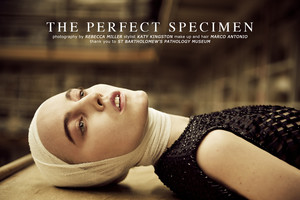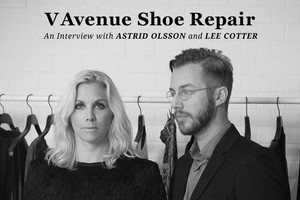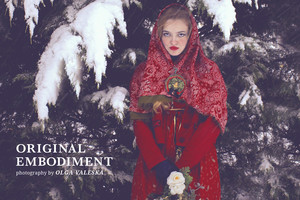The duo behind Christian Roth
Written by Solène Le BarsChristian Roth sunglasses first appeared on the runway in 1985; soon, the designers were tapped to create custom frames for the fashion shows of industry heavyweights and served on the eyewear design teams as well. « This was a time before every designer had an eyewear license », Eric Domege explains. « They wanted something avant-garde, and we worked with factories in Italy and France that could create exceptional pieces ». In 1990, Christian Roth was invited to join the CFDA (Council of Fashion Designers of America)—a first for an eyewear designer—and he is now a founding executive member of the Eyewear Designers of the CFDA.
More than 20 years after their initial release, Christian Roth Spring 2017 Collection continues to serve up stunning, subversive style directions through the Christian Roth debut. They are revisiting styles for which they are known : over-sized acetates and bold titanium creations, updated with an exciting array of new materials and construction techniques for a new generation of discerning eyewear enthusiasts.
Let’s start from the very beginning. How did both of you meet?
CR: We first met in New York in the early 1980s. We are from different countries—Eric is from France, Christian from Germany—but when we were very young we both had the vision to live in New York without really knowing what to do with our lives.
ED: We were very young.
CR: We are old, but not that old (laughs).
What made you specifically work in eyewear?
CR: Life is all about coincidences, it was not claimed. I was working on a shoot for the photographer Rico Puhlmann and the stylist asked me to go out and find cool sunglasses. I came back empty-handed even with an unlimited budget and sure that I would lose my job (laughs), it was nearly impossible to find anything cool. At the end of the day, I reported to Eric what had happened.
ED: I said to him « Let’s do it ourselves » ! We started with one architectural, minimalist and versatile frame style and lucky enough for us, quickly found fans who requested custom pairs.
CR: Suddenly, we started to see our products popping out on American and European editorials and fashion scenes, gracing some of fashion’s most famous faces along the way, on supermodels, musicians or artists.
ED: It basically begin like a trend laboratory. It all started when celebrity culture was much different. The company we founded together evokes an era before paid product placement and meticulously styled red carpet events became the norm in fashion. It was before mass production when you did things not only for money.
What is the most important thing about eyewear design for you?
CR: The right pair of shades can make anyone feel like a celebrity. Nothing is more rewarding to make a person happy and looking fabulous. We love designing eyewear because of our history. Eyewear is not a meaningless accessory; it’s an object with a function. It’s there to protect your eyes from the sun or to put lenses for your vision. It’s nice to create an object which has a function and to help people protect themselves or see better.
ED: Since our inception, we work with the prestigious DITA Group. Sharing a passion and a deep understanding of true luxury eyewear with our industry is important too.
Do you sometimes have to make compromises?
ED: We have to make adjustments on occasion which are not compromising regarding our design. It’s making things easier at last, this little detail which will make all the difference. It’s all about pointing the finger into other possibilities to do something really close to what we wanted to do.
CR: It’s always « give and take ». Let’s say you have 10 wishes and you can get 7, you see, that is maybe all right to give up 3.
ED: We are only truly categorical on two things : comfort and quality. Eyewear is all about balance. On one hand, our product is going to be on the face of consumer protecting one of the most precious organs of the human body; on the other hand, impossible to compromise with the high quality materials with which we work. The reason we use pure titanium is that there is no allergen; it is hyper light and flexible so it is easy for people who have to wear it all day long.
CR: Comfort comes first.
So quality and comfort describe your design aesthetic?
CR: And design.
ED: Design of course!
For whom do you design?
CR: We design for consumers who have a certain self-esteem. Unlike most designers who make sure their logos are visible, we brand our frames on the inside of the leg to maintain a certain style. This is for women and men who wants to look different with dashing glasses.
ED: We like to design so that our consumers get compliments on the frames they are wearing. We design for people who are looking for quality and craftsmanship. We are also looking for a product which has a history, a background. We have pure eyewear makers so we are concentrating on all of this.
CR: It’s storytelling quality, craftsmanship and individuality.
Your spring collection pays homage to some of your iconic archive collection, all the colors and forms are giving an entirely new graphic interpretation while remaining true to your classic shape; what inspired that direction?
CR: As designers, we serve a dual purpose: we are custodians of the past and creators of the future. Reviving some of our old frames allowed us to serve both roles at once, while exploring new ideas and experimenting with materials that did not exist 20 years ago.
ED: The reissue of our iconic Series 6558 frame as a part of our Archive Collection is incredibly important not just for our history, but for the history of grunge and for the history of celebrity culture. It’s the frames we did back in the old 1980s.
CR: Today, our silhouette attracts different types of consumers. Some of our feminine silhouette became unisex for example.
Are you proud of this collection?
ED: We are very happy. It has a really different flow because it’s a review of our past combined with the present and the future.
What inspired you?
CR: The unexpected! Inspiration is not a textbook. All designers and creative people have to take from what is happening around us now. We are lucky to have great experiences, and our own stories, but we cannot live in the past. That’s why we love traveling and being in different places. As long as you keep your eyes and ears open there will always be something new and which might inspire you.
ED: We always like to say as a matter of fact that our customers are our biggest inspiration. They are the one who make the final decision, who give the final step of approval. At the end part of our inspiration are our consumer because we hear their comments, their happiness or sometimes their positive criticism, which is very important.
How do you feel about what sunglass industry has become?
CR: It has exploded. The good news is that our industry grows every year and we hope it continues. Bad news is that the number of companies who not only take where there is strong inspiration from other true eyewear designers, also make become eyewear an uncertain quality. We had always believed that eyewear is not a hot summer product but conversely, for someone who treasures what they have. For this reason, we love to design timeless and high quality pieces. Because of our price point, it’s an investment. It should be part of a collection which grows up year by year thanks to consumer ability to always be up-to-date with their collection. This is kind of our idea.
ED: In recent years, we see a switch in consumers’s behavior. Most of the young people don’t want to be told what to wear or what to buy. The world is under fingertip of any devices, you can google a look or do your own research through social media. After this mass production, there is a rebound of coming to values of a real designer. The new generation is more rebellious and has more reflection about what they buy than in the past. They love stories behind products and want to know where it come from or how it is made. Actually, the more brand there is of big eyewear brand- which are not really eyewear (laughs), more people will be looking for individuality and quality.
CR: It’s obviously a good thing for designer like us.
What advice would you give young people wishing to follow in your footsteps?
ED: For young people, it’s harder today than when we began in the 1980s, no question. Today, consumers feel a necessity for quality, genius, custom services, etc. They expect a lot because of “big houses spoiling.”
CR: Somebody who has a talent and can create a look that's never been seen before- we would definitely not discourage a young person from starting an eyewear business. It’s a wonderful business for sure with wonderful customers, it’s a fact. Anybody who has a vision for eyewear and can have a place in this industry would be welcome.
What has been your proudest fashion moment?
CR: We are proud of all our accomplishment!
ED: One of our proud moment was in the early 2000, there was a huge exhibition in Triennale di Milano. They did a retrospective on eye-wear from the 1980s to the new millennium and they chose our brand to become the main focus of the exhibition. Eighty percent of the frames were our frames presented in one exclusive room. Unforgettable memory.
CR: We are also proud whenever big fashion magazines put our frames on cover—Vogue, New York Time Magazine, Madame Figaro, to name just a few—and walk by the street and see the magazine with a beautiful model shot close up, it’s gratifying.
ED: It’s a big compliment! Usually it never happen due to eye contact necessity.
You’re the first eyewear designers to join the prestigious CFDA. Tell us about that.
ED: Christian became a CFDA member in 1990, at a time when Anna Wintour and Candy Pratts-Price were trying to close the gap between eyewear and fashion. They had every type of designer, but no eyewear.
CR: They were not ready yet to establish an eyewear category, so basically we needed to make glasses for the fashion shows of big designers like Marc Jacobs and Michael Kors.
ED: So Marc Jacobs and Michael Kors god-fathered him into the CFDA.
CR: And 25 years later we have 15 eyewear design members. Thanks to that, we had the opportunity to create the edCFDA—Eyewear Designer of the CFDA—comity to organize a number of non-profit actions. Recently, in collaboration with ten eyewear designer, all members of the CFDA, we have created a special capsule of frames in aid of Fashion Targets Breast Cancer that raises funds and public awareness for breast cancer worldwide. To refer to the previous question, this is the latest of our proud moments!
Who takes on what role in the company?
CR: We have no role place. We make every decision together. I’m not saying we always agree; it would be boring (laughs).
ED: We have to convince each other or it just goes. A famous designer quote is totally true « Out of the hundred percent of what a designer designs, ninety percent goes into the trash ».
CR: Design is a constant challenge, we don’t take it personally if it’s going to the trash.
What is it like working with each other?
CR: It’s the biggest privilege to have somebody you can trust so much. It’s great to share with your partner the same vision and to have the same dream and to compliment each other. Definitely, four eyes see more than two eyes.
What are you working on at the moment?
ED: It’s take about a year from the drawing to the finished product, so we are already working on next year’s collection and still doing the finishing touches of the collection we launch in Fall.
CR: We’re working on a new initiative with the CFDA but we can't say more (laughs).
What are your hopes and dreams for the future?
CR: Peace.
ED: Today is even more relevant than before!







